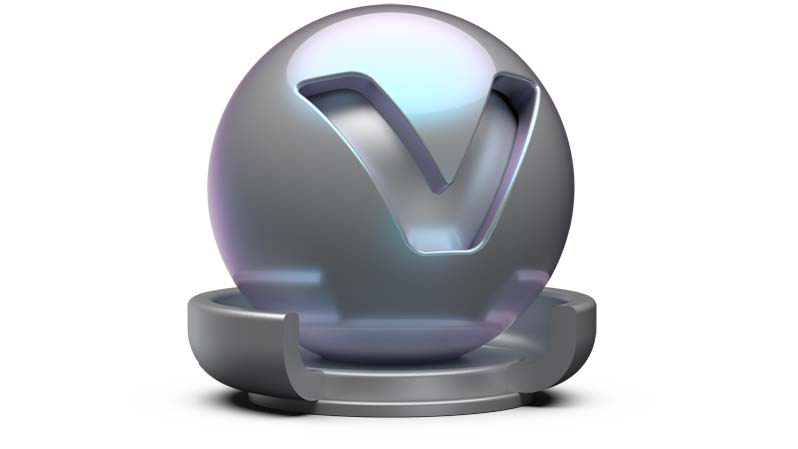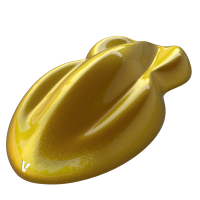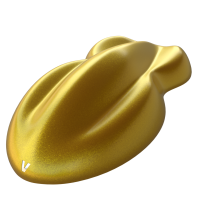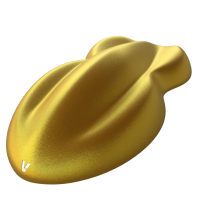Flipflop

Flipflop car paint material provides two layers of flakes on top of the base coat color. Its appearance depends heavily on the viewing angle between surface and observer. The effect is seen with paint on show and model cars.
Video captions: Create a FlipFlop material and assign it to your geometries. In this case, let’s replace the given varnish select nodes and apply it to the selected nodes. We can find the same material settings as with the Metallic Carpaint material. In addition, there are two flake color settings and one blending controller; therefore, the varnish’s color is a blend of the base color and the flake color. The two flake colors depend on the angle of view. While using the Blending controller, you can set the power measure of the two flake colors. You can add some more detail to your orange metallic varnish by simply changing the values slightly.
Flipflop Carpaint Material Settings
- Base Color - This attribute defines the basic color, the main characteristic of the material. Use the slider to change the brightness. Click the color field on the right to open the color chooser.
Flakes
Describes the metallic flake’s behavior, which is embedded in metallic paints. They have a strong specular light reflection and are layered on top of the base shading color.
Flake Color 1 - Defines the color of the metallic particles on top of the lacquer layer. It gets stronger and more brilliant the further the normal orientation points away from the camera.
Flake Color 2 - Defines the color of the metallic particles on the second layer of flakes. It gets stronger and more brilliant the further the normal orientation points towards the camera.
Blending - Defines the mixture ratio of two colors. Drag the slider to the left to increase the intensity of color one. Drag the slider to the right to increase the intensity of color two.
Roughness - Sets the roughness of the flake surfaces. A lower value represents a smoother surface resulting in more specular reflections, while a higher value represents a rough surface resulting in more diffuse reflections.
Flake Size - Sets the size of the metallic particles on top of the lacquer layer. The higher the value, the larger the flakes in the paint.
Flake Intensity - Sets the amount of variation in the flake´s normal directions.
Clearcoat
The clearcoat is a transparent, reflective paint layer on the base paint layer.
Type - Defines the intensity of a reflection, based on the viewing angle. Its intensity at normal incidence is set by the material's reflectivity. Choose from the following:
Color - Sets the pigment color of the clearcoat, which slightly darkens the overall color of the brushed metal.
Refraction Index - Sets the material's refraction index. The index of refraction allows glass-on-glass contact situations. It shows the amount the rays are reflected off the surface versus absorbed (refracted into the surface).
Roughness - Imitates clearcoat spray paint high-gloss satin and matte finishes in OpenGL, CPU raytracing, and GPU raytracing. Now, you can control the roughness, thickness, and density of the clearcoat for most materials, such as Plastic, Brushed Metal, Metallic Carpaint, and Carbon (2D/3D).
Roughness of 0 Roughness of 0.1 Roughness of 1.0 

 Video Player is loading.
Video Player is loading.
Video captions: Additionally, we have added now more advanced clearcoat options to all materials that can have a clearcoat. Now, you can achieve interesting satin paints in OpenGL using the new Roughness slider.
Thickness - Sets the thickness of the clearcoat.
Density - Determines the concentration of particles in the clearcoat, which affects the color of the clearcoat. Use this in combination with Thickness and a non-white color, as white is completely transparent.
Use Orange Peel - Applies a bump structure to the layer. Use the following options to customize this:
Orange Peel Frequency - Sets the bump structure's noise frequency. The higher the value, the closer together the orange peel bumps.
Orange Peel Intensity - Sets the bump structure's intensity. The higher the value, the more visible the orange peel and less smooth the clearcoat surface.
For further information on the other attributes, see the following: